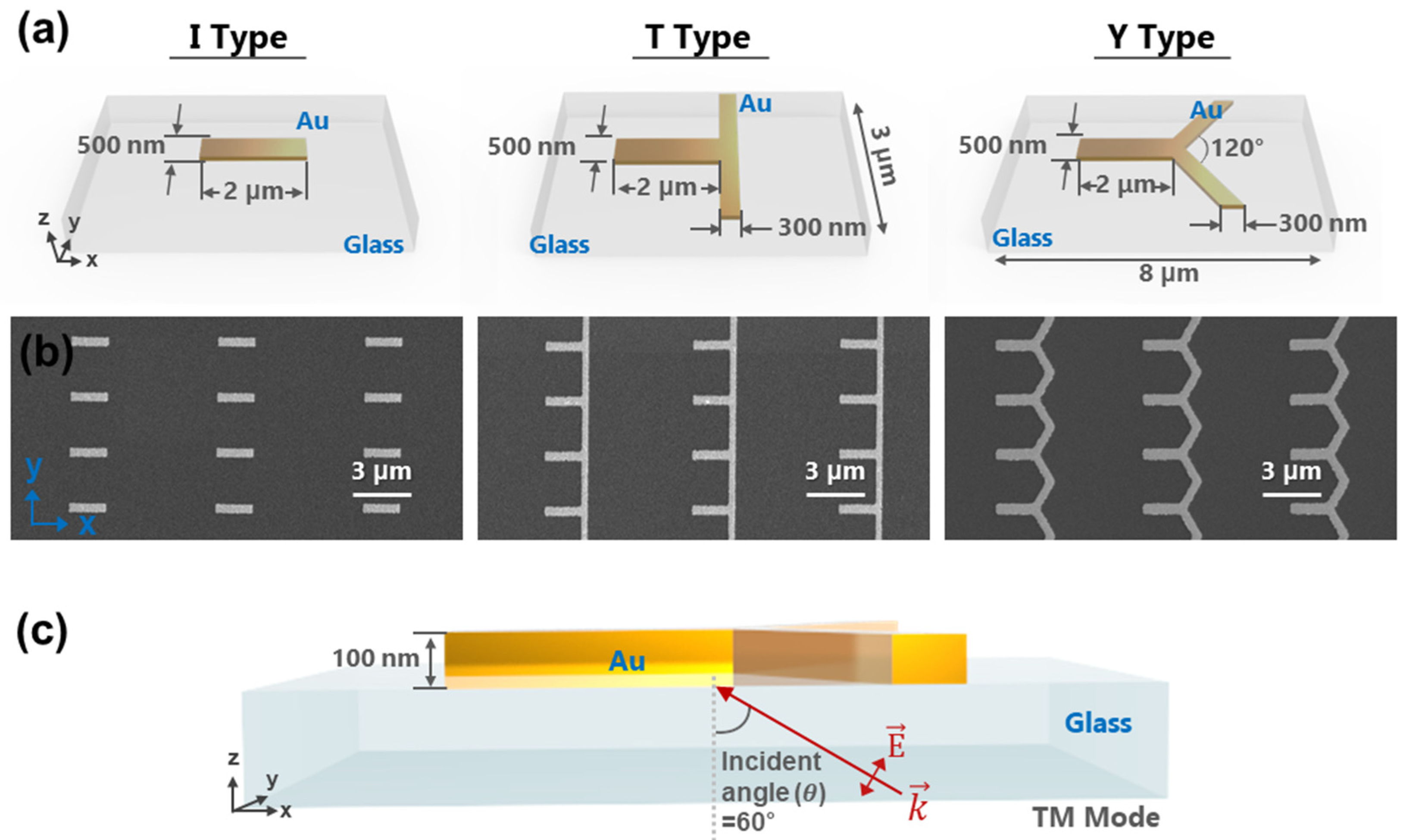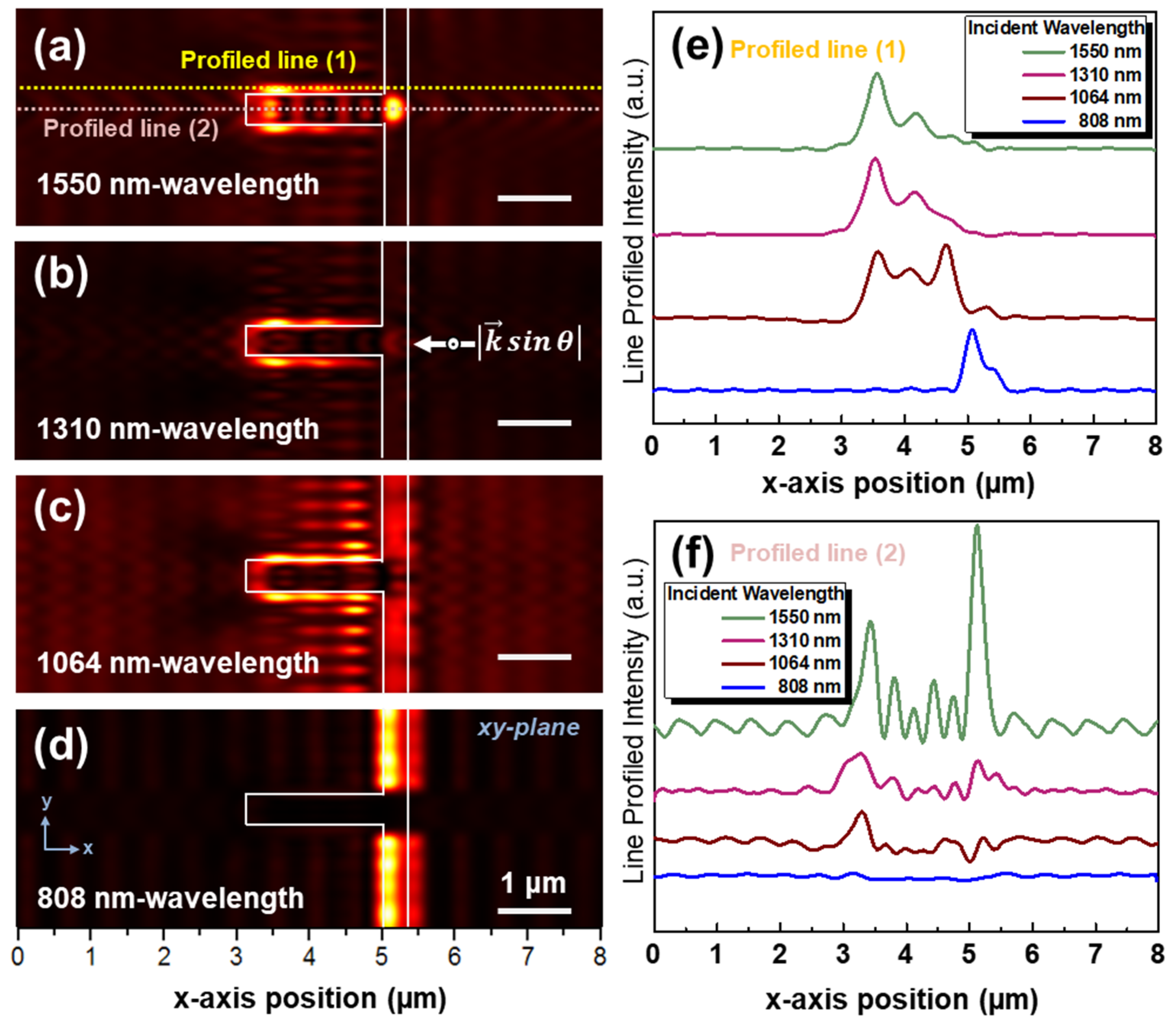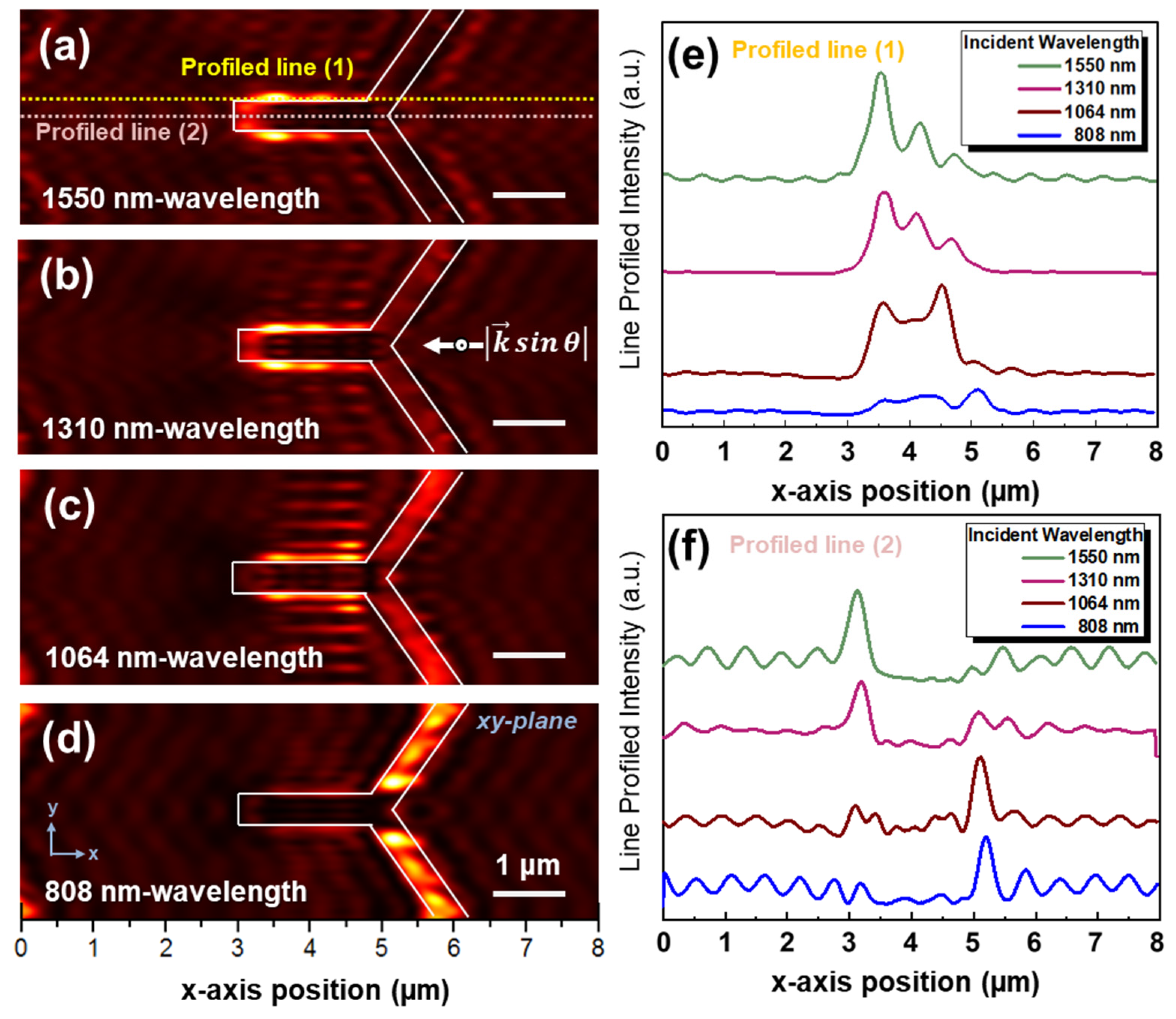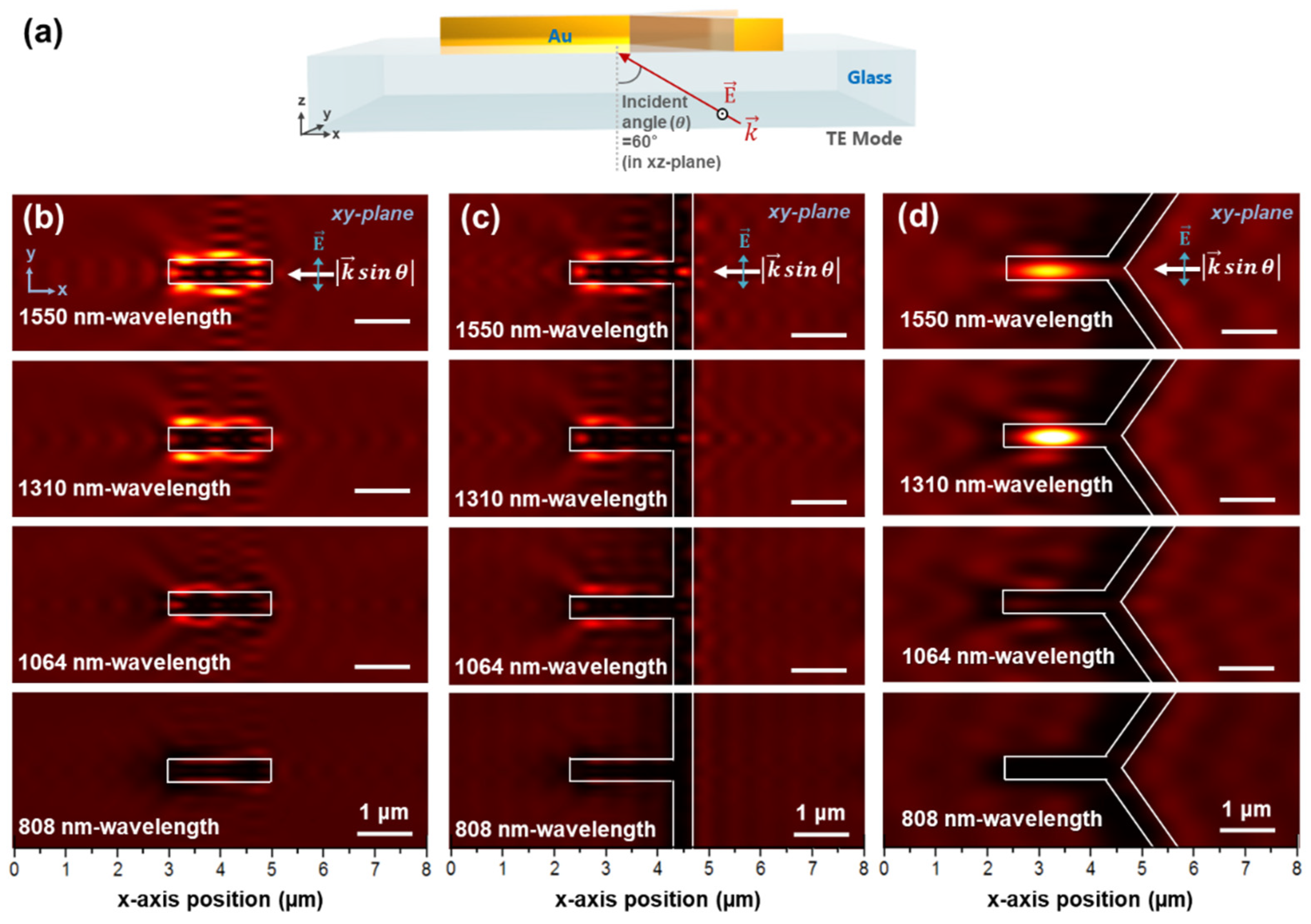Localized Surface Plasmon Fields Manipulation on Nanostructures Using Wavelength Shifting
Abstract
:1. Introduction
2. Materials and Methods
3. Results
4. Discussion
Author Contributions
Funding
Institutional Review Board Statement
Informed Consent Statement
Data Availability Statement
Conflicts of Interest
References
- Ahn, H.; Song, H.; Choi, J.-r.; Kim, K. A localized surface plasmon resonance sensor using double-metal-complex nanostructures and a review of recent approaches. Sensors 2018, 18, 98. [Google Scholar] [CrossRef] [PubMed] [Green Version]
- Gish, D.A.; Nsiah, F.; McDermott, M.T.; Brett, M.J. Localized surface plasmon resonance biosensor using silver nanostructures fabricated by glancing angle deposition. Anal. Chem. 2007, 79, 4228–4232. [Google Scholar] [CrossRef] [PubMed]
- Kim, K.; Kim, D.J.; Moon, S.; Kim, D.; Byun, K.M. Localized surface plasmon resonance detection of layered biointeractions on metallic subwavelength nanogratings. Nanotechnology 2009, 20, 315501. [Google Scholar] [CrossRef] [PubMed] [Green Version]
- Kim, S.A.; Byun, K.M.; Kim, K.; Jang, S.M.; Ma, K.; Oh, Y.; Kim, D.; Kim, S.G.; Shuler, M.L.; Kim, S.J. Surface-enhanced localized surface plasmon resonance biosensing of avian influenza DNA hybridization using subwavelength metallic nanoarrays. Nanotechnology 2010, 21, 355503. [Google Scholar] [CrossRef] [Green Version]
- Valsecchi, C.; Brolo, A.G. Periodic metallic nanostructures as plasmonic chemical sensors. Langmuir 2013, 29, 5638–5649. [Google Scholar] [CrossRef] [PubMed]
- Kugel, V.; Ji, H.F. Nanopillars for sensing. J. Nanosci. Nanotechnol. 2014, 14, 6469–6477. [Google Scholar] [CrossRef] [PubMed]
- Li, W.; Ren, K.; Zhou, J. Aluminum-based localized surface plasmon resonance for biosensing. Trends Anal. Chem. 2016, 80, 486–494. [Google Scholar] [CrossRef]
- Oh, Y.; Kim, K.; Hwang, S.; Ahn, H.; Oh, J.-W.; Choi, J.-r. Recent advances of nanostructure implemented spectroscopic sensors—A brief overview. Appl. Spectrosc. Rev. 2016, 51, 656–668. [Google Scholar] [CrossRef]
- Choi, J.-r.; Kim, K.; Oh, Y.; Kim, A.L.; Kim, S.Y.; Shin, J.-S.; Kim, D. Extraordinary transmission based plasmonic nanoarrays for axially super-resolved cell imaging. Adv. Opt. Mater. 2014, 2, 48–55. [Google Scholar] [CrossRef]
- Wei, F.; Lu, D.; Shen, H.; Wan, W.; Ponsetto, J.L.; Huang, E.; Liu, Z. Wide field super-resolution surface imaging through plasmonic structured illumination microscopy. Nano Lett. 2014, 14, 4634–4639. [Google Scholar]
- Choi, J.-r.; Lee, S.; Kim, K. Plasmon based super resolution imaging for single molecular detection: Breaking the diffraction limit. Biomed. Eng. Lett. 2014, 4, 231–238. [Google Scholar] [CrossRef]
- Oh, Y.; Son, T.; Kim, S.Y.; Lee, W.; Yang, H.; Choi, J.-r.; Shin, J.-S.; Kim, D. Surface plasmon-based nanoscopy of intracellular cytoskeletal actin filaments using random nanodot arrays. Opt. Express 2014, 22, 27695–27706. [Google Scholar] [CrossRef] [PubMed]
- Fernández-Domínguez, A.I.; Liu, Z.; Pendry, J.B. Coherent four-fold super-resolution imaging with composite photonic–plasmonic structured illumination. ACS Photon. 2015, 2, 341–348. [Google Scholar] [CrossRef]
- Lee, W.; Kim, K.; Kim, D. Electromagnetic near-field nanoantennas for subdiffraction-limited surface plasmon-enhanced light microscopy. IEEE J. Sel. Top. Quantum Electron. 2012, 18, 1684–1691. [Google Scholar]
- Wertz, E.; Isaacoff, B.P.; Flynn, J.D.; Biteen, J.S. Single-molecule super-resolution microscopy reveals how light couples to a plasmonic nanoantenna on the nanometer scale. Nano Lett. 2015, 15, 2662–2670. [Google Scholar] [CrossRef]
- Allen, K.W.; Farahi, N.; Li, Y.; Limberopoulos, N.I.; Walker Jr., D.E.; Urbas, A.M.; Liberman, V.; Astratov, V.N. Super-resolution microscopy by movable thin-films with embedded microspheres: Resolution analysis. Ann. Phys. 2015, 527, 513–522. [Google Scholar] [CrossRef] [Green Version]
- Lin, H.; Centeno, S.P.; Su, L.; Kenens, B.; Rocha, S.; Sliwa, M.; Hofkens, J.; Uji-I, H. Mapping of surface-enhanced fluorescence on metal nanoparticles using super-resolution photoactivation localization microscopy. Chem. Phys. Chem. 2012, 13, 973–981. [Google Scholar] [CrossRef]
- Ishikawa, S.; Hayasaki, Y. Super-resolution complex amplitude reconstruction of nanostructured binary data using an interference microscope with pattern matching. Opt. Express 2013, 21, 18424–18433. [Google Scholar] [CrossRef]
- Tanaka, Y.; Kaneda, S.; Sasaki, K. Nanostructured potential of optical trapping using a plasmonic nanoblock pair. Nano Lett. 2013, 13, 2146–2150. [Google Scholar] [CrossRef] [PubMed]
- Thompson, J.D.; Tiecke, T.G.; de Leon, N.P.; Feist, J.; Akimov, A.V.; Gullans, M.; Zibrov, A.S.; Vuleti, V.; Lukin, M.D. Coupling a single trapped atom to a nanoscale optical cavity. Science 2013, 340, 1202–1205. [Google Scholar] [CrossRef] [PubMed]
- Kotnala, A.; Gordon, R. Quantification of high-efficiency trapping of nanoparticles in a double nanohole optical tweezer. Nano Lett. 2014, 14, 853–856. [Google Scholar] [CrossRef]
- Berthelot, J.; Aćimović, S.S.; Juan, M.L.; Kreuzer, M.P.; Renger, J.; Quidant, R. Three-dimensional manipulation with scanning near-field optical nanotweezers. Nat. Nanotechnol. 2014, 9, 295. [Google Scholar] [CrossRef]
- Kim, T.; Ahn, H.; Song, H.; Kim, K.; Choi, J.-r. Comparative study of nanolithography based on extraordinary and diffracted optical transmissions. Opt. Laser Technol. 2019, 119, 105658. [Google Scholar] [CrossRef]
- Kim, K.; Yoon, S.J.; Kim, D. Nanowire-based enhancement of localized surface plasmon resonance for highly sensitive detection: A theoretical study. Opt. Express 2006, 14, 12419–12431. [Google Scholar] [CrossRef] [PubMed]
- Shen, H.; Guillot, N.; Rouxel, J.; de la Chapelle, M.L.; Toury, T. Optimized plasmonic nanostructures for improved sensing activities. Opt. Express 2012, 20, 21278–21290. [Google Scholar] [CrossRef]
- Deng, Y.; Liu, Z.; Song, C.; Hao, P.; Wu, Y.; Liu, Y.; Korvink, Y.G. Topology optimization of metal nanostructures for localized surface plasmon resonances. Struct. Multidiscip. Optim. 2016, 53, 967–972. [Google Scholar]
- Wei, H.; Zhang, S.; Tian, X.; Xu, H. Highly tunable propagating surface plasmons on supported silver nanowires. Proc. Natl. Acad. Sci. USA 2013, 110, 4494–4499. [Google Scholar] [CrossRef] [PubMed] [Green Version]
- Wang, Z.; Wei, H.; Pan, D.; Xu, H. Controlling the radiation direction of propagating surface plasmons on silver nanowires. Laser Photonics Rev. 2014, 4, 596–601. [Google Scholar] [CrossRef]
- Moharam, M.G.; Gaylord, T.K. Rigorous coupled-wave analysis of planar-grating diffraction. J. Opt. Soc. Am. 1981, 71, 811–818. [Google Scholar] [CrossRef]
- Byun, K.M.; Kim, S.J.; Kim, D. Design study of highly sensitive nanowire-enhanced surface plasmon resonance biosensors using rigorous coupled wave analysis. Opt. Express 2005, 13, 3737–3742. [Google Scholar]
- Wan, C.; Gaylord, T.K.; Bakir, M.S. Rigorous coupled-wave analysis equivalent-index-slab method for analyzing 3D angular misalignment in interlayer grating couplers. Appl. Opt. 2016, 55, 10006–10015. [Google Scholar] [CrossRef] [PubMed]
- Wang, Q.; Zhang, D.; Yang, H.; Tao, C.; Huang, Y.; Zhuang, S.; Mei, T. Sensitivity of a label-free guided-mode resonant optical biosensor with different modes. Sensors 2012, 12, 9791–9799. [Google Scholar] [CrossRef] [PubMed]
- Tseng, A.A.; Chen, K.; Chen, C.D.; Ma, K.J. Electron beam lithography in nanoscale fabrication: Recent development. IEEE Trans. Electron. Packag. Manuf. 2003, 26, 141–149. [Google Scholar] [CrossRef] [Green Version]
- Hicks, E.M.; Zou, S.; Schatz, G.C.; Spears, K.G.; Van Duyne, R.P.; Gunnarsson, L.; Rindzevicius, T.; Kasemo, B.; Käll, M. Controlling plasmon line shapes through diffractive coupling in linear arrays of cylindrical nanoparticles fabricated by electron beam lithography. Nano Lett. 2005, 5, 1065–1070. [Google Scholar] [CrossRef] [PubMed]
- Chen, Y. Nanofabrication by electron beam lithography and its applications: A review. Microelectron. Eng. 2015, 135, 57–72. [Google Scholar] [CrossRef]
- Hammond, J.; Rosamond, M.; Sivaraya, S.; Marken, F.; Estrela, P. Fabrication of a horizontal and a vertical large surface area nanogap electrochemical sensor. Sensors 2016, 16, 2128. [Google Scholar] [CrossRef] [Green Version]
- Ionescu, R.; Aybeke, E.; Bourillot, E.; Lacroute, Y.; Lesniewska, E.; Adam, P.M.; Bijeon, J.L. Fabrication of annealed gold nanostructures on pre-treated glow-discharge cleaned glasses and their used for localized surface plasmon resonance (LSPR) and surface enhanced Raman spectroscopy (SERS) detection of adsorbed (bio) molecules. Sensors 2017, 17, 236. [Google Scholar] [CrossRef] [Green Version]
- Manfrinato, V.R.; Stein, A.; Zhang, L.; Nam, C.Y.; Yager, K.G.; Stach, E.A.; Black, C.T. Aberration-corrected electron beam lithography at the one nanometer length scale. Nano Lett. 2017, 17, 4562–4567. [Google Scholar] [CrossRef]
- Agrawal, A.; Majdi, J.; Clouse, K.; Stantchev, T. Electron-beam-lithographed nanostructures as reference materials for label-free scattered-light biosensing of single filoviruses. Sensors 2018, 18, 1670. [Google Scholar] [CrossRef] [Green Version]
- Khlebtsov, N.G. T-matrix method in plasmonics: An overview. J. Quant. Spectrosc. Radiat. Transf. 2013, 123, 184–217. [Google Scholar] [CrossRef]
- Son, T.; Lee, C.; Moon, G.; Lee, D.; Cheong, E.; Kim, D. Enhanced surface plasmon microscopy based on multi-channel spatial light switching for label-free neuronal imaging. Biosens. Bioelectron. 2019, 146, 111738. [Google Scholar] [CrossRef] [PubMed]
- Shi, C.; Wu, J.B.; Pan, D. Review on near-infrared heptamethine cyanine dyes as theranostic agents for tumor imaging, targeting, and photodynamic therapy. J. Biomed. Opt. 2016, 21, 050901. [Google Scholar] [CrossRef] [PubMed]
- Hong, G.; Antaris, A.L.; Dai, H. Near-infrared fluorophores for biomedical imaging. Nat. Biomed. Eng. 2017, 1, 10. [Google Scholar] [CrossRef]
- D’Orlando, A.; Mevellec, J.-Y.; Louarn, G.; Humbert, B. Atomic force microscopy nanomanipulation by confocal Raman multiwavelength spectroscopy: Application at the monitoring of resonance profile excitation changes of manipulated carbon nanotube. J. Phys. Chem. 2020, 124, 2705–2711. [Google Scholar] [CrossRef]
- D’Orlando, A.; Bayle, M.; Louarn, G.; Humbert, B. AFM-nano manipulation of plasmonic molecules used as “Nano-Lens” to enhance Raman of individual nano-objects. Materials 2019, 12, 1372. [Google Scholar] [CrossRef] [Green Version]
- Heeg, S.; Clark, N.; Vijayaraghavan, A. Probing hotspots of plasmon-enhanced Raman scattering by nanomanipulation of carbon nanotubes. Nanotechnology 2018, 29, 465710. [Google Scholar] [CrossRef]
- Simoncelli, S.; Li, Y.; Cortés, E.; Maier, S.A. Nanoscale Control of Molecular Self-Assembly Induced by Plasmonic Hot-Electron Dynamics. ACS Nano 2018, 12, 2184–2192. [Google Scholar] [CrossRef] [Green Version]






Publisher’s Note: MDPI stays neutral with regard to jurisdictional claims in published maps and institutional affiliations. |
© 2021 by the authors. Licensee MDPI, Basel, Switzerland. This article is an open access article distributed under the terms and conditions of the Creative Commons Attribution (CC BY) license (https://creativecommons.org/licenses/by/4.0/).
Share and Cite
Song, H.; Ahn, H.; Kim, T.; Choi, J.-r.; Kim, K. Localized Surface Plasmon Fields Manipulation on Nanostructures Using Wavelength Shifting. Appl. Sci. 2021, 11, 9133. https://doi.org/10.3390/app11199133
Song H, Ahn H, Kim T, Choi J-r, Kim K. Localized Surface Plasmon Fields Manipulation on Nanostructures Using Wavelength Shifting. Applied Sciences. 2021; 11(19):9133. https://doi.org/10.3390/app11199133
Chicago/Turabian StyleSong, Hyerin, Heesang Ahn, Taeyeon Kim, Jong-ryul Choi, and Kyujung Kim. 2021. "Localized Surface Plasmon Fields Manipulation on Nanostructures Using Wavelength Shifting" Applied Sciences 11, no. 19: 9133. https://doi.org/10.3390/app11199133
APA StyleSong, H., Ahn, H., Kim, T., Choi, J.-r., & Kim, K. (2021). Localized Surface Plasmon Fields Manipulation on Nanostructures Using Wavelength Shifting. Applied Sciences, 11(19), 9133. https://doi.org/10.3390/app11199133





